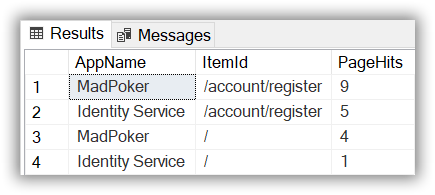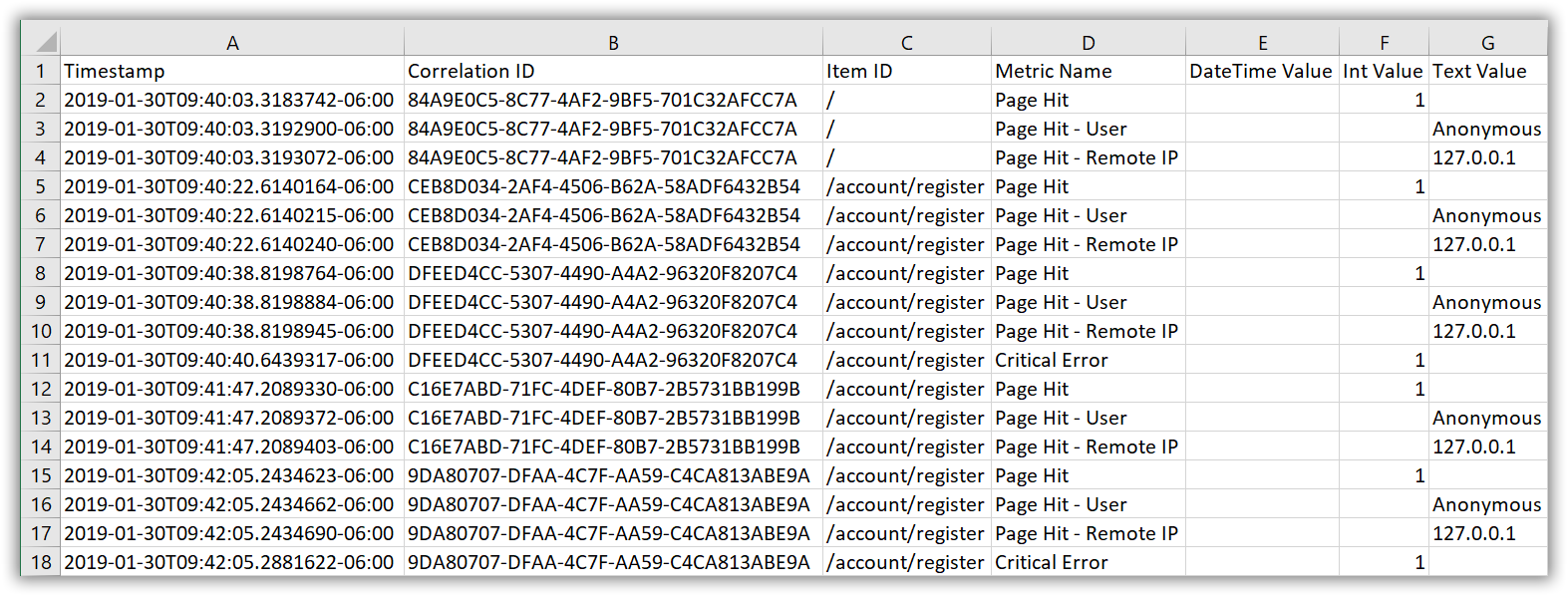A zero latency, thread-safe logger that writes to files and / or a database.
I was motivated to write my own logging component for the following reasons.
- It is unclear whether third-party logging solutions are thread-safe. To avoid unnecessary allocations (compared to Transient or Scoped), I want to use a Singleton-scoped instance that is dependency-injected during the startup of ASP.NET Core MVC websites or WebAPI services. This Singleton-scoped instance, of course, must be safe for use by multiple controller instances responding to multiple, concurrent HTTP requests.
- It is unclear whether third-party logging solutions write logs on a background thread. I want to write copious logs in my source code without impacting application performance.
- It's possible to answer the questions I raise in reasons 1 and 2 with a little research. But I didn't want to expend the mental energy to read and understand someone's else code when I could direct that energy toward writing my own code. In addition, writing my own code has the advantage of not introducing bloat (features I don't require).
- While it's important to "know your resources", that is, leverage components freely available on the Internet, I do not blindly follow this guidance when the component I need is easy to write. Why reference a bloated logging solution that's attempting to be all things to all people when I can write my own solution that satisfies my requirements in a few hundred lines of code? Don't blindly be a mash-up artist.
- When faced with the choice of mashing together third-party components or writing your own...
- If the two approaches require roughly equal amounts of mental energy...
- If the initial effort to grok the third-party components is high or effort to write your own component is low...
- If persistent effort is required to work around kludges caused by third-party components that don't do exactly what you need...
- Write your own code.
- Safe for use as a Singleton-scoped instance in multi-threaded, highly-concurrent applications such as websites and services.
- Targets .NET Standard 2.0 so it may be used in .NET Core or .NET Framework runtimes.
- Writes tracing, performance, and metric logs.
- Writes to files (one file each for tracing, performance, and metric) or a database.
- Writes to both files and a database via the ConsolidatedLogger class. Why write to both targets? You could configure the file and database loggers differently or enable one of the loggers to send trace messages to the Console in addition to its target. Typically, I write only to a database logger.
- Includes a CorrelationId so you may see related messages across processes (within the same application) and across tracing, performance, and metric logs.
- Configurable
- AppName and ProcessName. The ProcessName is meant to indicate the layer in your n-tier application architecture, such as "Website", "Service", or "Data Load".
- TraceFilename, PerformanceFilename, and MetricFilename
- TraceLogLevel
- CriticalError
- Error
- Warning
- Info
- Debug
- SendTraceMessagesToConsole (true or false, in addition to the target file or database)
- MessageFormat (for text files)
- MessageOnly
- IncludeTimestamp
- IncludeTimestampCorId
- IncludeTimestampCorIdLevel
If you're developing an ASP.NET Core MVC website or WebAPI service, I highly recommend installing my AspNetCore.Middleware solution, which uses this component to automatically write tracing, performance, and metric logs for all invocations of controller actions (page hits and service method calls). See my AspNetCore.Middleware solution for more details.
This component relies on BlockingCollection, so logs accumulate in process memory before they're written to disk or to a database. This async design (fast I/O writes to memory on the application thread, slow I/O writes to a data store on a background thread) is what makes this component so fast, causing practically zero latency on your application thread. As a trade off (speed for memory), this component may use large amounts of memory in high-traffic websites and services. This has not been an issue for me, though I admit I have not stress-tested the component.
- Use SQL Server Management Studio to locate an existing database or create a new database.
- Run the CreateDatabase.sql script to create the tables, views, and indices used by this solution. The script creates SQL objects in a "Logging" schema. Obviously, if you install this solution in a dedicated database there's no risk of colliding with the names of existing SQL objects. However, if you install this solution in an existing database the schema minimizes the risk of colliding with existing SQL objects.
- Reference this component in your solution via its NuGet package.
Construct file and database loggers:
Guid correlationId = Guid.NewGuid(); // Will use in later code samples.
string appName = "Sales Orders";
string processName = "Service";
// I recommend you bind these settings directly from appSettings.json,
// but I'll write them here explicitly for clarity.
FileLoggerSettings fileLoggerSettings = new FileLoggerSettings
{
AppName = appName,
ProcessName = serviceName,
MessageFormat = MessageFormat.IncludeTimestampCorIdLevel,
TraceFilename = @"C:\Users\Erik\Documents\SalesOrdersTrace.log",
PerformanceFilename = @"C:\Users\Erik\Documents\SalesOrdersPerformance.csv",
MetricFilename = @"C:\Users\Erik\Documents\SalesOrdersMetric.csv"
};
DatabaseLoggerSettings databaseLoggerSettings = new DatabaseLoggerSettings
{
AppName = appname,
ProcessName = processName,
TraceLogLevel = LogLevel.Debug,
Connection = "Data Source=SqlServerName;Initial Catalog=LoggingDatabaseName;Integrated Security=True"
};
ILogger fileLogger = new ConcurrentFileLogger(fileLoggerSettings);
ILogger databaseLogger = new ConcurrentDatabaseLogger(databaseLoggerSettings);
ILogger consolidatedLogger = new ConsolidatedLogger(new List<ILogger>{ fileLogger, databaseLogger });Configure dependency injection in ASP.NET Core:
Services.AddSingleton(typeof(ILogger), consolidatedLogger);
// Now any controller can request the logger by including an "ILogger Logger" parameter in its constructor.
public AccountController(IAppSettings AppSettings, ILogger Logger, IAccountService AccountService) :
base(AppSettings, Logger)
{
_accountService = AccountService;
}Log a message with or without a correlation ID:
logger.Log(correlationId, $"{Program.AppSettings.Logger.ProcessName} starting.");
logger.Log($"{Program.AppSettings.Logger.ProcessName} starting.");Log an exception with or without a correlation ID:
try
{
Foo();
}
catch(Exception exception)
{
logger.Log(correlationId, exception);
logger.Log(exception);
}Log performance with or without a correlation ID:
Stopwatch stopwatch = Stopwatch.StartNew();
ExpensiveOperation();
stopwatch.Stop();
logger.LogPerformance(correlationId, nameof(ExpensiveOperation), stopwatch.Elapsed);
logger.LogPerformance(nameof(ExpensiveOperation), stopwatch.Elapsed);Log a metric, such as a sales order of a particular product by a particular user, with or without a correlation ID:
logger.LogMetric(correlationId, product.Number, "Orders by Product Number", order[product.Number].Quantity);
logger.LogMetric(correlationId, HttpContext.User.Identity.Name, "Orders by User", order.TotalQuantity);
logger.LogMetric(product.Number, "Orders by Product Number", order[product.Number].Quantity);
logger.LogMetric(HttpContext.User.Identity.Name, "Orders by User", order.TotalQuantity);I'll dispense with my sales order example, since I don't actually have that data. I used a sales orders example to illustrate what's possible with my logger. I'll show you instead the data automatically logged by by my AspNetCore.Middleware solution, which uses this component.
Find all tracing logs related to a given correlation ID:
select t.*
from[Logging].TraceLogsLastDay t
where t.CorrelationId = '9DA80707-DFAA-4C7F-AA59-C4CA813ABE9A'
order by t.Id descNote that cross-process logs may appear slightly out-of-order even if two processes (such as a website and a service) run on the same machine because each process writes to its own queue. The queues are read by ThreadPool threads so the order logs are read from the queue and written to the data store is not guaranteed. In other words, logs from two processes that run sequentially (website calls service and waits for response) may interleave. However, the order of logs written by a single process on a single machine is preserved.
Find all tracing logs for a given application since a given point in time:
select t.*
from[Logging].TraceLogsLastDay t
where t.Timestamp > '01/30/2019 9:42 AM'
order by t.Id descFind all critical errors:
select t.*
from[Logging].TraceLogsLastDay t
where t.LogLevel = 'Critical Error'
order by t.Id descOnce again, I'll promote my AspNetCore.Middleware solution that enables exception details to flow from a SQL database through a service to a website, displaying a full cross-process stack trace (related by CorrelationId) in the web browser and in the logs. It's manifestly clear from this stack trace that failure to check the uniqueness of the new user's email address caused the following exception:
Exception Type = ErikTheCoder.Logging.SimpleException
Exception Correlation ID = 9DA80707-DFAA-4C7F-AA59-C4CA813ABE9A
Exception App Name = MadPoker
Exception Process Name = Website
Exception Message = POST with application/x-www-form-urlencoded content type to /account/register resulted in HTTP status code 500.
Exception StackTrace = at System.Environment.get_StackTrace()
at [trimmed for brevity]
at ErikTheCoder.MadPoker.Website.Controllers.AccountController.Register(RegisterModel Model) in C:\Users\Erik\Documents\Visual Studio 2017\Projects\MadPoker\Website\Controllers\AccountController.cs:line 95
at [trimmed for brevity]
at System.Net.Http.HttpContent.WaitAndReturnAsync[TState,TResult](Task waitTask, TState state, Func`2 returnFunc)
at System.Threading.ExecutionContext.RunInternal(ExecutionContext executionContext, ContextCallback callback, Object state)
at System.Runtime.CompilerServices.AsyncTaskMethodBuilder`1.AsyncStateMachineBox`1.MoveNext()
at System.Threading.ThreadPoolWorkQueue.Dispatch()
Exception Type = ErikTheCoder.Logging.SimpleException
Exception Correlation ID = 9DA80707-DFAA-4C7F-AA59-C4CA813ABE9A
Exception App Name = MadPoker
Exception Process Name = Website
Exception Message = An exception occurred when a Refit proxy called a service method.
Exception StackTrace = at System.Environment.get_StackTrace()
at [trimmed for brevity]
at ErikTheCoder.MadPoker.Website.Controllers.AccountController.Register(RegisterModel Model) in C:\Users\Erik\Documents\Visual Studio 2017\Projects\MadPoker\Website\Controllers\AccountController.cs:line 95
at [trimmed for brevity]
at System.Net.Http.HttpContent.WaitAndReturnAsync[TState,TResult](Task waitTask, TState state, Func`2 returnFunc)
at System.Threading.ExecutionContext.RunInternal(ExecutionContext executionContext, ContextCallback callback, Object state)
at System.Runtime.CompilerServices.AsyncTaskMethodBuilder`1.AsyncStateMachineBox`1.MoveNext()
at System.Threading.ThreadPoolWorkQueue.Dispatch()
Exception Type = ErikTheCoder.Logging.SimpleException
Exception Correlation ID = 9DA80707-DFAA-4C7F-AA59-C4CA813ABE9A
Exception App Name = Identity Service
Exception Process Name = Service
Exception Message = POST with application/json; charset=utf-8 content type to /account/register resulted in HTTP status code 500.
Exception StackTrace = at System.Environment.get_StackTrace()
at [trimmed for brevity]
at ErikTheCoder.Identity.Service.Controllers.AccountController.RegisterAsync(RegisterRequest Request) in C:\Users\Erik\Documents\Visual Studio 2017\Projects\IdentityService\Service\Controllers\AccountController.cs:line 128
at System.Data.SqlClient.SqlCommand.<>c__DisplayClass127_2.b__1(Task`1 readTask)
at System.Threading.ExecutionContext.RunInternal(ExecutionContext executionContext, ContextCallback callback, Object state)
at System.Threading.Tasks.Task.ExecuteWithThreadLocal(Task& currentTaskSlot)
at System.Threading.ThreadPoolWorkQueue.Dispatch()
Exception Type = System.Data.SqlClient.SqlException
Exception Correlation ID = 9DA80707-DFAA-4C7F-AA59-C4CA813ABE9A
Exception App Name = Identity Service
Exception Process Name = Service
Exception Message = Cannot insert duplicate key row in object 'Identity.Users' with unique index 'UX_Users_EmailAddress'. The duplicate key value is (username@emailservice.net).
Exception StackTrace = at System.Data.SqlClient.SqlConnection.OnError(SqlException exception, Boolean breakConnection, Action`1 wrapCloseInAction)
at System.Data.SqlClient.SqlInternalConnection.OnError(SqlException exception, Boolean breakConnection, Action`1 wrapCloseInAction)
at System.Data.SqlClient.TdsParser.ThrowExceptionAndWarning(TdsParserStateObject stateObj, Boolean callerHasConnectionLock, Boolean asyncClose)
at System.Data.SqlClient.TdsParser.TryRun(RunBehavior runBehavior, SqlCommand cmdHandler, SqlDataReader dataStream, BulkCopySimpleResultSet bulkCopyHandler, TdsParserStateObject stateObj, Boolean& dataReady)
at System.Data.SqlClient.SqlDataReader.TryHasMoreRows(Boolean& moreRows)
at System.Data.SqlClient.SqlDataReader.TryReadInternal(Boolean setTimeout, Boolean& more)
at System.Data.SqlClient.SqlDataReader.<>c__DisplayClass190_0.b__1(Task t)
at System.Data.SqlClient.SqlDataReader.InvokeRetryable[T](Func`2 moreFunc, TaskCompletionSource`1 source, IDisposable objectToDispose)
--- End of stack trace from previous location where exception was thrown ---
at Dapper.SqlMapper.ExecuteScalarImplAsync[T](IDbConnection cnn, CommandDefinition command) in C:\projects\dapper\Dapper\SqlMapper.Async.cs:line 1217
at ErikTheCoder.Identity.Service.Controllers.AccountController.RegisterAsync(RegisterRequest Request) in C:\Users\Erik\Documents\Visual Studio 2017\Projects\IdentityService\Service\Controllers\AccountController.cs:line 128
at [trimmed for brevity]
at Microsoft.AspNetCore.Builder.RouterMiddleware.Invoke(HttpContext httpContext)
at Microsoft.AspNetCore.Diagnostics.ExceptionHandlerMiddleware.Invoke(HttpContext context)
See the performance of code:
select p.*
from [Logging].OperationsAvgDurationLastDay p
order by p.AppName asc, p.OperationName ascIn SQL Server database:
In Excel (opening the .csv text file written by logger):
See the performance of code for a given correlation ID:
select * from [Logging].PerformanceLogsLastDay p
where p.CorrelationId = 'F4B3F067-CC8C-4329-AAA3-9CF60D646AAE'
order by p.Id descSee page hits:
select m.AppName, m.ItemId, count(*) as PageHits
from [Logging].MetricLogsLastDay m
where m.MetricName = 'Page Hit'
group by m.AppName, m.ItemId
order by count(*) descIn SQL Server database:
In Excel (opening the .csv text file written by logger):
The metric log is intended to collect data to be analyzed using SQL "group by" queries with count, sum, or avg functions.
See metrics for a given correlation ID:
select m.Timestamp, m.HostName, m.AppName, m.ProcessName, m.ItemId, m.MetricName,
m.IntValue, m.TextValue, m.DateTimeValue
from [Logging].MetricLogsLastDay m
where m.CorrelationId = 'F4B3F067-CC8C-4329-AAA3-9CF60D646AAE'
order by m.Id desc



